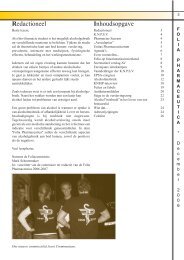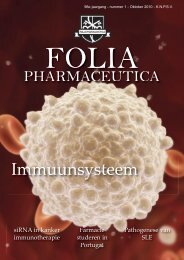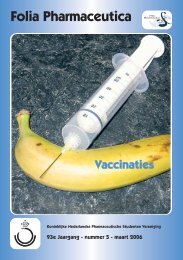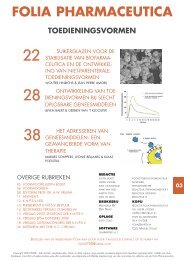Folia jaargang 100 - Nr.1 - Koninklijke Nederlandse ...
Folia jaargang 100 - Nr.1 - Koninklijke Nederlandse ...
Folia jaargang 100 - Nr.1 - Koninklijke Nederlandse ...
Create successful ePaper yourself
Turn your PDF publications into a flip-book with our unique Google optimized e-Paper software.
24<br />
Theresa Nguyen<br />
After my whirlwind experience as an IPSF exchange<br />
student in Utrecht, the Netherlands this past summer,<br />
I am finally back in the United States! The<br />
things I learned in the Netherlands were invaluable<br />
and the experience was nothing short of amazing.<br />
During my exchange in the Netherlands, I received<br />
many questions regarding how differently pharmacy<br />
is practiced in America and how pharmacy study differs<br />
from the Dutch system. I would like to offer you<br />
some insight into the American pharmacy practice<br />
and pharmacy study.<br />
America boasts more than 130 pharmacy schools<br />
amongst its 50 states, with an average of <strong>100</strong> pharmacy<br />
students per graduating class. Pharmacy is only<br />
offered as a doctorate degree and mainly focuses on<br />
patient-focused care; meanwhile biopharmacy is a<br />
graduate program which focuses more heavily on research.<br />
Unlike in the Netherlands, biopharmacy and<br />
pharmacy students do not integrate or share the<br />
same organizations because there is a definite distinction<br />
between the two. As a pharmacy student,<br />
I will mostly discuss how the pharmacy doctorate<br />
program is structured in the United States.<br />
First and foremost, I would like to explain how<br />
higher education in America differs from the Netherlands.<br />
Students generally complete a bachelor’s<br />
degree and afterwards apply to more advanced programs<br />
(i.e., masters, PhD, doctorates) if desired.<br />
<strong>Folia</strong> Pharmaceutica<br />
Studying Pharmacy<br />
Therefore, pharmacy students average a total of 7<br />
or 8 years of higher level education because students<br />
complete 4 years of undergraduate studies,<br />
then 3 or 4 years of pharmacy school depending on<br />
which program the school offers. Pharmacy schools<br />
offer one of two types of curriculum: traditional<br />
or accelerated. The two curriculums differ mostly<br />
by the amount of years it takes to graduate. Traditional<br />
curriculums are 4-year programs; meanwhile<br />
the accelerated curriculum is completed in only 3<br />
years. Regardless of the program, the first years of<br />
the program are lecture-based and the last year in<br />
pharmacy school is comprised solely of internships<br />
and pharmacy rotations.<br />
I am enrolled in the accelerated pharmacy program,<br />
which means I attend school year-round for two<br />
years and complete one year of internships in my<br />
final year. My program also teaches using a block<br />
system, meaning that a new topic is taught every<br />
2 weeks and an exam is administered at the end of<br />
every 2 weeks to test student’s knowledge of that<br />
specific subject. The first year of pharmacy school<br />
starts off with foundational science and an emphasis<br />
on biochemistry, biopharmaceutics, pharmacodynamics<br />
and pharmacokinetics. These are all individual<br />
courses which focus on the types of receptors<br />
associated with specific organs and tissues and the<br />
effects those receptors have on the body when<br />
agonists or antagonists are introduced to the system.<br />
As the school year progresses, more challenging<br />
subjects are introduced to help students understand<br />
why certain medications are used in certain<br />
disease states and how it works in the body. In the








